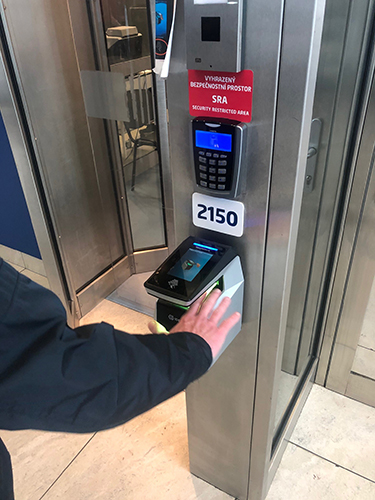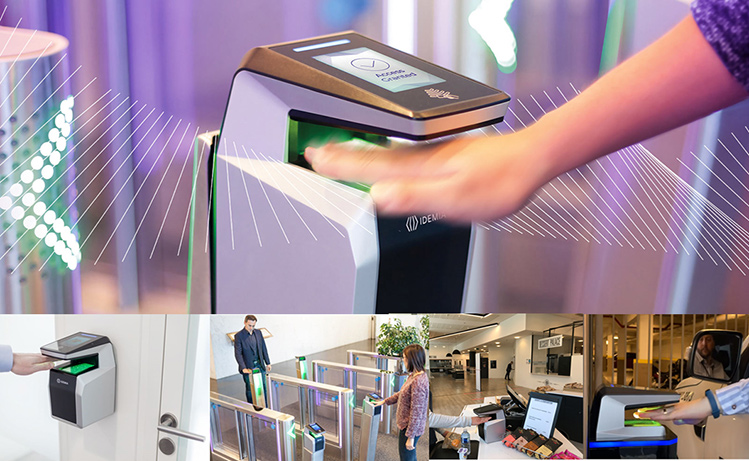An interview with Nicolas Raffin, VP Marketing Biometric Devices, IDEMIA. By Ross Falconer
Many innovative solutions are being developed for the new normal in airport facilitation post-COVID-19. Contactless biometrics for access control is one important area, in terms of offering both a hygienic and frictionless experience.

Prague Airport has deployed more than 60 MorphoWave Compact readers in its Security Restricted Areas. The airport combines MorphoWave fingerprint scanning with the use of its existing access badge to provide a two-factor authentication.
“Let’s first be clear,” begins Nicolas Raffin, VP Marketing Biometric Devices, IDEMIA. “For us, one-finger touch biometric readers are still an efficient biometric option, and there are simple and efficient ways to make them compliant with COVID-19 processes: by regularly cleaning/disinfecting the sensor, or by installing a gel dispenser next to the reader. The worst option would be to disable or remove such readers, because COVID did not eliminate the reasons why biometrics were needed. This being said, contactless biometric terminals are particularly well-suited for high-traffic locations where high throughputs are needed, as they reduce the various steps in biometric verification.”
Being contactless, of course, provides a hygiene benefit, since users do not touch the sensor or any part of the device. IDEMIA’s MorphoWave device scans four fingerprints in less than one second through a fully touchless hand gesture.
VisionPass, meanwhile, is a face recognition device for access control. “We have received a great response level to this new product for staff access control,” says Raffin. “First of all, for its technology and performance level that matches airports’ needs – efficiency with a large number of users, on a variety of indoor and outdoor locations – but also as it is perceived, like MorphoWave, as a safe and secure option to efficiently protect staff who do not have to touch any part of the device.”
When designing VisionPass, IDEMIA sat down with integrators, clients and users to understand their needs and pains with facial recognition in particular. This shaped the specification for IDEMIA’s R&D department, and Raffin emphasises that there was no compromise on security, as well as user convenience and satisfaction.
In July 2020, VisionPass won the Security Industry Association (SIA) New Product Showcase Award in the Biometric category. “This is a key recognition of the technical and performance excellence of our product,” says Raffin. “Receiving this award proves that both our approach, and the ‘recipe’ chosen, were good ones. We are also very proud because we received the same prestigious award two years ago when we launched MorphoWave, our contactless fingerprint scanner.”
MorphoWave devices are deployed in many airports worldwide, offering frictionless biometric access. “For us, frictionless means security, speed and convenience,” Raffin comments. “Under COVID, that also means hygienic, since when you wave the hand you don’t touch any part of the device.”
Prague Airport has deployed more than 60 MorphoWave Compact readers in its Security Restricted Areas. The airport combines MorphoWave fingerprint scanning with the use of its existing access badge to provide a two-factor authentication.

IDEMIA’s MorphoWave device scans four fingerprints in less than one second through a fully touchless hand gesture.
In June 2020, it was announced that IDEMIA’s MorphoWave contactless fingerprint technology outperformed all other devices in the National Institute of Standards and Technology (NIST)’s latest Accuracy and Interoperability Test on all criteria involved. “This is another recognition by NIST of the excellence of our biometric algorithms, and this is very important for clients selecting a biometric terminal, because it is primarily meant for security, so it should be very reliable and accurate,” Raffin explains. “This test, in particular, is quite interesting as it confirms MorphoWave’s capability to efficiently scan and verify, in a contactless way, fingerprints that were initially captured in a contact way and stored in a legacy database.”
IDEMIA has a powerful biometric offer with VisionPass and MorphoWave, and Raffin’s message to airports is clear. “First of all, I would say: deploy biometrics. You have access badges with a staff photo, but is that enough to ensure who is using the badge? Biometrics is the only authentication factor to guarantee it. Due to the number of staff, variety of profiles, and variety of locations to equip in an airport – doors, gates, parking, indoor or outdoor – go for contactless biometrics that will provide a very high level of accuracy even for large numbers of users, a high throughput, and great user convenience to facilitate adoption and avoid lengthy complicated training.”







